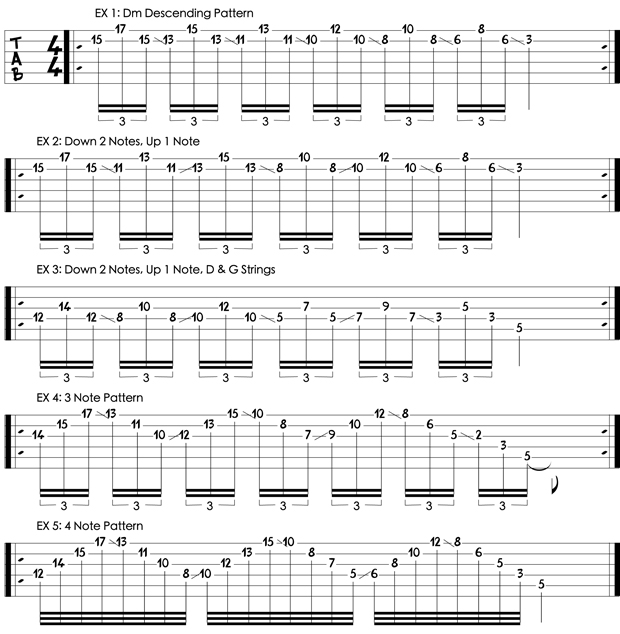A Guide to Pentatonic Slides
Learn one of the best ways to transition up and down the neck on the fly.

In this lesson, I’ll be demonstrating one of the best ways to transition up and down the neck on the fly.
I frequently utilize this technique because it’s easy to play fast and expand into many complex riffs and ideas.
The premise of this lesson is based on visualizing the pentatonic scale on one string and expanding it into two-, three- or four-note patterns using adjacent strings.
Let’s start with its most basic form in EXAMPLE 1.
EXAMPLE 1 is based on a descending D minor pentatonic scale on the B string. I play a pattern off of every note in the scale—two frets higher on the E string. Then I use my first finger to slide on the B string to the next note in the D minor pentatonic scale. This creates a cascading effect and keeps the fingering very simple. To complete this example, I add a pattern off the Bb on the 11th fret to give it some more color. Be sure to memorize this scale pattern before moving on the next examples.
For EXAMPLE 2, I play the same pattern and scale, but in a different sequence. This time, the sequence is down two notes in the scale followed by one note up in the scale. This adds to the cascading sound of this technique and creates a great effect with minimal effort from your left hand.
EXAMPLE 3 is nearly identical to EXAMPLE 2, just moved to the D and G strings. Be sure to use the same fingering as the prior examples. Once you have this example down, try moving it down two frets to the E and A strings.
EXAMPLE 4 is where things start to get interesting. For this example, utilize the pattern EXAMPLE 2, but double up the highest note of every pattern with its lower octave on the G string. This creates a three-note sweep pattern. The trick to keeping this simple is only thinking about the note you’re playing on the B string. Stick to the original scale pattern and you’ll have this lick down in no time.
Moving on to our final example, EXAMPLE 5 takes this concept a step further and expands it into a four-note sweep pattern. This is accomplished by doubling up both notes of our original pattern with their lower octaves on the D and G strings. To take this lick to another level, really try to accentuate the slides between positions. By accenting the slides, it will sound cleaner and more modern.
This one string scale approach can be used in all types of musical contexts. I tend to use it in solos, but I’ve found it works just as well on the lower strings for writing riffs. I hope these licks spark some creative ideas for you and open some new doors in your playing. Keep shredding! Cheers!

Sammy Boller is a guitarist from Detroit, MI. His debut instrumental record will be released later this year. To contact Sammy or ask him a question, email him at sammyboller@gmail.com or follow him on Instagram @sammyboller
Get The Pick Newsletter
All the latest guitar news, interviews, lessons, reviews, deals and more, direct to your inbox!











